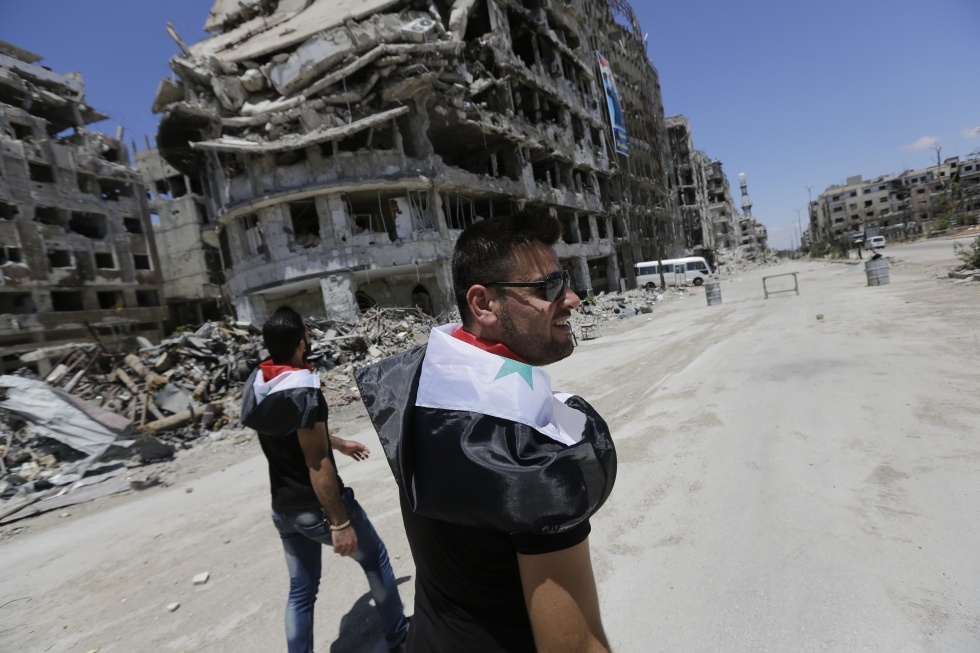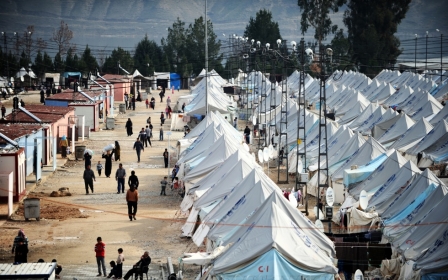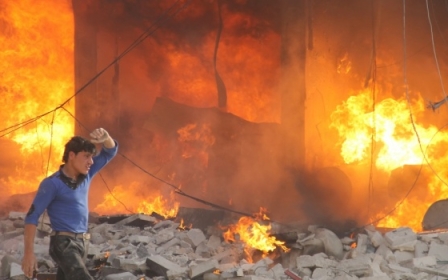Civilians become weapons in Syria's Civil War

BEIRUT - With 160,000 dead and millions displaced, few deny that civilians have borne the brunt of Syria’s civil war. A particularly troubling tactic of war that has emerged recently is an apparent targeting of civilians with the aim of gaining the upper hand in negotiations.
As the war has raged on, the targeting of civilians appears to have become a coordinated and deliberate policy for both opposition and government forces. Residents and human rights groups say both sides have used the tactic, sparking debate over what constitutes "legitimate targets" in a complex war increasingly played out by non-state groups.
The trend appears clear in Homs - there government forces had been imposing what has been dubbed a "starvation or surrender siege" that restricted food and supplies including to civilians until a deal struck last month saw some 1,200 mainly Islamist Sunni rebels withdraw from the Old City.
While the government was blocking supplies to rebel-held areas, opposition forces were launching mortars, missiles and detonated car bombs in the mostly civilian neighbourhoods dominated by the Alawite sect of Syrian President Bashar al-Assad.
Human-rights workers, rights groups and humanitarian workers say the rebel’s bombing strategy aimed at putting pressure on the government - through using its loyalist populations - to end the siege.
Human Rights Watch, which is preparing a report to be released soon on attacks against civilians in Syria, directly documented a number of incidents of car bombs and retaliatory mortar fire in Homs in the weeks before the deal.
In the report, whose findings were shared with MEE, HRW found that many of these attacks originated from rebel-held neighbourhoods.
Patterns of repeated fire against "mosques, churches, markets and schools” show that fire is “either indiscriminate or they are deliberately targeting civilian neighbourhoods," said HRW's Syria and Lebanon researcher Lama Fakih.
"There were a number of cases where it was quite clear that the rebels were trying to put pressure on the government to make a deal," she said, adding that in other cases, "it was not necessarily to make a deal, but in response to previous attacks".
The effect on civilians, HRW has found, is disproportionate and amounts to "an ongoing and systematic policy of targeting civilians and may amount to crimes against humanity".
In Homs and also in Damascus, where rebel-held areas have surrendered in response to civilian calls to end punitive government sieges, the use of civilians appears to have had at least some military success, which could reduce the incentives of both parties to stop.
Likewise, in Homs, rebel attacks on government-held neighbourhoods worked to pressure the civilians to push the government to end the siege, a Red Crescent official in Homs familiar with the negotiations said and other rebel fighters corroborated.
"It's a way of saying: 'Look we are right next to you'," the official said.
"It worked. The Alawite civilians were asking the government to do whatever they had to, to make it stop."
Civilian-military divide blurs
Complicating the picture further is the fact that in an increasingly bitter civil war, the lines between civilian and military targets have become blurred.
On the one hand, opposition fighters frequently mix with civilian populations. On the other, non-state actors have stepped in to provide a leading combat role, with support often coming from sectarian-aligned and locally-sourced paramilitary groups from the pro-government "National Defense Forces" and "shabiha" (paramilitary groups that mix with civilian neighbourhoods) - have stepped in to provide a leading combat role.
One former rebel fighter, speaking via Skype from Waer in Homs, and using the pseudonym 'Faysal Homs', argued that targeting government neighbourhoods was a legitimate response to government tactics that he said also targeted civilians. Moreover, he argued the areas were home to a large number of "shabiha", and therefore legitimate targets.
"I will ask you, when the government targets civilians with the barrel bombs over the children in Aleppo and Waer, that is legitimate?" he asked.
"Yes," he replied when asked if Alawite neighbourhoods were legitimate targets, "because the government and [shabiha] are living between the people in Akrama".
HRW's Fakih said it is important to distinguish between those who are sympathetic or supportive of the government and those that are fighting in armed conflict or direct combatants.
"That does not make them legitimate targets," she said of supporters from either side.
In a number of cases, she said, the al-Qaeda-linked al-Nusra Front has even targeted areas without military targets. Likewise, she says, where fighters are mixing with civilian populations, "then they are not taking due care in protecting the civilian community".
Protecting the community has been a campaign cry for both sides in Syria. The government used this in the lead up to May’s presidential election, while the opposition has repeatedly claimed that it is protecting against the abuses committed by Assad forces. Both parties have promoted a narrative presenting themselves as the legitimate representatives of their constituents.
Despite the rhetoric, however, many civilians - who have found themselves stuck in the middle – appear to no longer care who wins as long as order is restored and their suffering eased, although this dream looks like it may be as far away as ever.
"Everybody knows that if there is an attack on the Alawite neighbourhoods, the following day, don't go to school, don't go to the market, don't leave the house," said one Homs resident, sympathetic to the opposition but living in a government-held neighbourhood.
"We feel solidarity with them [the rebels], but wish it wouldn't reflect on us," he added, while asking that his name not be used for security reasons.
Conflict escalation
Research by human-rights groups and political activists is increasingly showing that as the apparent use of civilians as a tactic has grown, so too has hostility and antagonism felt at a local level.
Reciprocal attacks have pitted neighbour against neighbour, serving to harden either pro-government or opposition positions and polarising communities even further, residents and rights groups say.
With the increase in number of so-called "truce deals" expanding in Damascus, Homs, and now even Aleppo in recent months, these policies are only likely to continue.
In Aleppo, rebels recently cut services and utilities from government-held neighbourhoods. It appears they did this to negotiate an end to the relentless government assault on Aleppo which has seen the city targeted by indiscriminate weapons like barrel bombs.
The policy failed. In April, the al-Nusra Front, along with the local Shariah Council reached a deal with the Syrian government to restore electricity to government-held neighbourhoods, in exchange for a suspension of the barrel campaign.
Several weeks later though, the bombs were still falling even as Islamist forces cut off water to all of Aleppo, leaving civilians on both sides to scrounge for water for 12 days.
How the rebels cut supply to both government-held and their own supporters remains vague, and could have been a botched engineering error, but the effect was the same; up to one million people were left without drinking water.
Asked about the service cuts, a member of the media office of the Islamic Front, a powerful coalition of Islamist rebels, said they would not damage the reputation of the rebels.
"People are understanding," the media office member said, adding that "The Islamic Front protects civilians."
"The Islamic Front policy is just targeting the government's military areas," he said via Skype. "We avoid shelling any district that might cause harm to the civilians- whether these civilians are from the Assad's supporters or not…We care a lot for the civilians' lives; their safety is paramount."
Aleppo residents from both sides say they are tired and want the violence to end. And while anger is mounting towards all warring factions, it is mostly directed at "the other side" - wherever the mortars are coming from.
One elderly Aleppo resident and opposition supporter said he couldn't understand why the rebels would target their own side.
"I am with the opposition. I am against the government, so why are they punishing me? I am an old man, I can't help them," he said.
Another young university student and government supporter explained his position, arguing a truce could only happen when the “wrong side” was "cleared" by the army.
"I know there are innocent civilians there [on the rebel side] and that these barrel [bombs] are not accurate, but at the same time these people let these terrorists use their houses and their balconies to throw the gas canisters and mortars."
"We are tired and just want this to stop - whatever the cost."
HRW’s Fakih, who has interviewed civilians in both rebel and government-held territory across says civilian responses vary, depending on their affiliations and experiences.
"When incidents like this happen… civilians become more hardened in their opposition to the opposing party," she said.
"In other cases there is just anger at both sides and a sense that there is no safe place for them to go."
New MEE newsletter: Jerusalem Dispatch
Sign up to get the latest insights and analysis on Israel-Palestine, alongside Turkey Unpacked and other MEE newsletters
Middle East Eye delivers independent and unrivalled coverage and analysis of the Middle East, North Africa and beyond. To learn more about republishing this content and the associated fees, please fill out this form. More about MEE can be found here.






